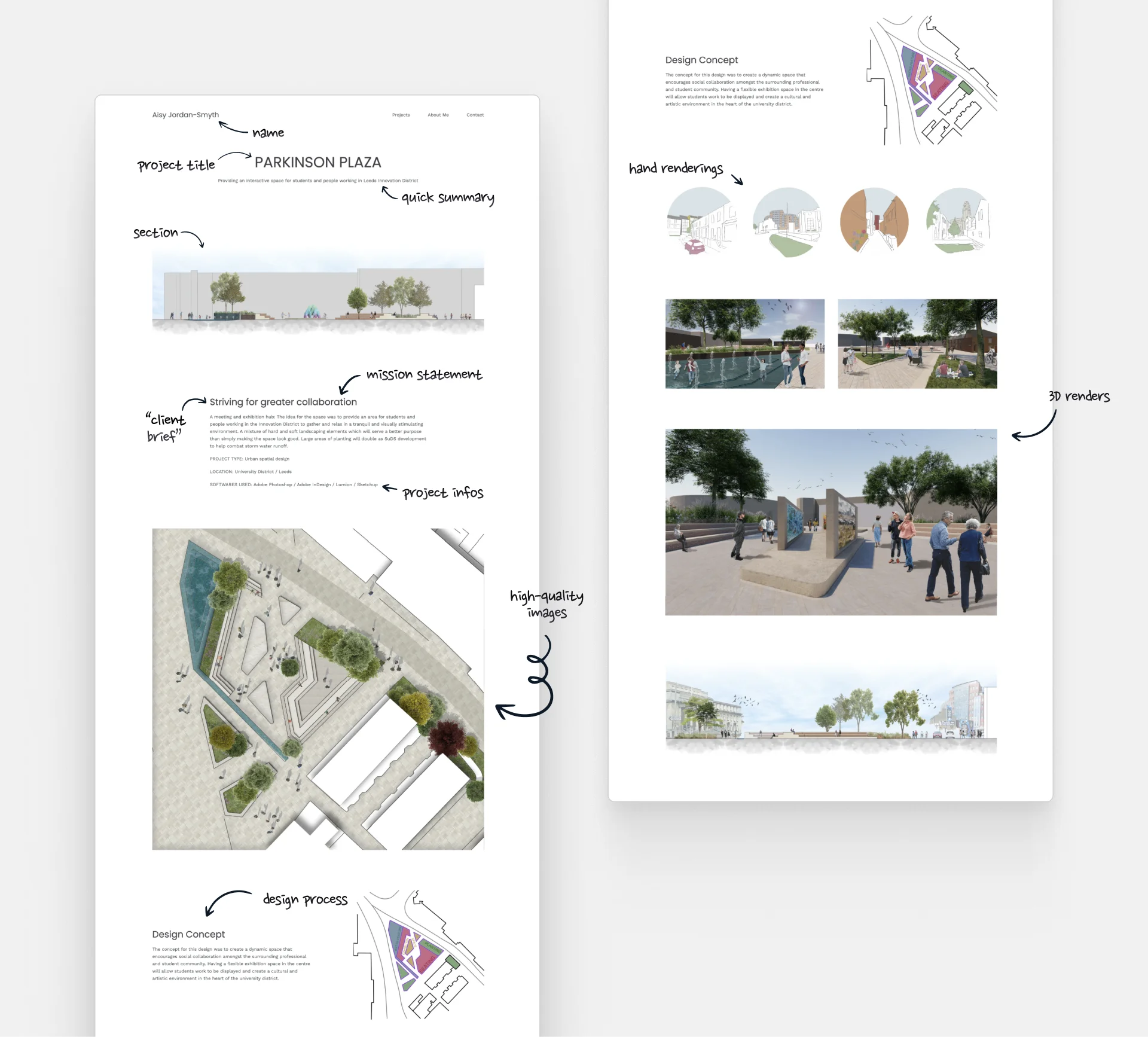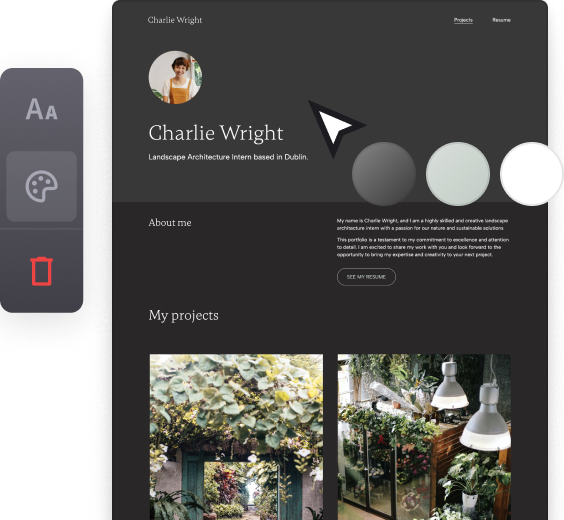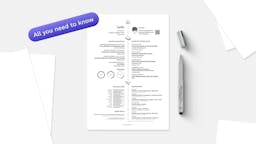
13 Tips to Make a Strong Landscape Architecture Portfolio
Simply having a landscape architecture portfolio isn’t enough anymore. It needs to stand out.
Get ready to discover some next-level tips and turn your application from a "meh" into a "hell yes". We also brought you some brilliant examples for inspiration and an innovative tool to set up your portfolio in a matter of minutes; Archifolio.
13 Tips for a Strong Landscape Architecture Portfolio
1. Take 5 minutes
Before you do anything portfolio-related, just take a couple of minutes and do the following exercise to align your thoughts. It doesn't—and shouldn't—take more than 5 minutes, but it can save you a tremendous amount of time in the long run.
Write down (or just think about) your answers to the following questions:
- What is my goal with my portfolio?
- Who will see/evaluate it?
- What's the first thing they'll want to know?
- What do I want them to do after reviewing my portfolio?
Don't jump to any conclusions yet, just collect your thoughts. And then when you're finished with your answers, highlight some action items.
This exercise will help you set your priorities, decide which format you should choose for your portfolio, and which and how many projects you should include.
Example #1 - Portfolio Main page by Aisy Jordan-Smyth
Undergraduate Landscape Architecture Portfolio by Aisy Jordan-Smyth
Check out Aisy Jordan-Smyth's stunning undergraduate landscape architecture portfolio. With the light background and her stunning visuals, she created a welcoming home page for her projects. She included them on separate pages but placed some intriguing thumbnails that lead to them right away.
2. Keep it short
It may be tempting to show the full range of different projects you have ever worked on in your application, but don’t. The key to a good portfolio is keeping it short and relevant.
Of course, depending on your goal, the number of projects will differ. If you're applying for a job, the shorter and more relevant your portfolio is the better. If, however, you're trying to land clients, more projects help state your expertise better.
If you have the time, we suggest the following:
- Create a master portfolio with all of the work you're proud of. It's not for a relevant job or to land a client. Rather it's a collection of your high-quality work that's always available, even on short notice.
- Create an application portfolio. This needs to be relevant for the job or for the type of client, however, it should also show your range.
- Create a short, intriguing work sample. This is tailor-made for the specific job at hand and only includes 1-3 projects.
If you follow this order, you'll have all of your projects to cherry-pick from for each application. And with the right tool, this doesn't mean that you have to actually create different portfolios every time.
With Archifolio, you can create your master portfolio website quickly and easily. You can decide which projects should appear and which shouldn't. You can also export the relevant projects to PDF to create an application portfolio or a work sample.
How many projects should you include?
It depends on your seniority level and the goal you want to achieve.
If you're a student, you can get away with having 1-2 projects, but as you get more experience you should include between 3-6 projects. Including more will start to become distracting.
If you're a freelancer or a small studio, however, it's best if you have as many quality projects published as possible, as more projects mean more experience and therefore more trust.
Which of your projects should you include?
When you choose which pieces to include, consider the following:
- Date of the project. Regularly update your portfolio to present your best and most recent work. This might mean you need to say goodbye to some old favorites to make space.
- State of the projects. Finished designs land you clients. Sketches show the versatility of your skills to employers. Remember your 5-minute exercise in the beginning when selecting your pieces.
- Common theme. Show what you’re specializing in, or what connects your projects. You can build your entire portfolio around a concept, such as sustainability, which will help you select what’s relevant and what isn’t.
- Your goal. Your portfolio has a purpose: always be mindful of how you can best serve it.
3. Tell a story
Every project presents a story. Starting from the building site’s conditions, you walk your audience through your design process and end up with a master plan, or photographs of the end result.
The right structure can help you with telling this story. A tried and true formula is the following:
- Show part of the result or master plan as your hook,
- The most important information for context with the client brief,
- Territorial analysis,
- The “before” state of the site,
- Initial sketches,
- Concept,
- Masterplan, and
- Photography of the result (or the “after”).
Example #2 - Project page by Aisy Jordan-Smyth
Parkinson Plaza - Project by Aisy Jordan-Smyth
We love that looking at this project page, we actually read about a story of how she came up with her ideas. Thus, she gave some proof of how she turns her conceptual ideas into detailed plans.
4. Tailor your portfolio to your audience
Depending on who you identified in the beginning as your target audience, you have different considerations to make.
Job application
When it comes to applying for a job at a landscape design studio, start with a quick search (in the job description and the company’s website) and find the following information:
- Project types of the company (commercial, industrial, residential landscape design, etc),
- Required work experience for the position,
- Scope of activities and necessary skills for that position,
- Must-know software, and
- If the company has any specialization or niche.
This will help you create your resume and your portfolio. Highlight those of your skills that are relevant to your future employer and show them why you will be perfect for the job.
It will also help with what to include. For example, if you know that your tasks will mostly be creating concept designs, you won’t be tempted to include all of the construction documents you’ve made.
Client work
If you are looking to get hired by clients, you will need to highlight something completely different. Your main focus should be your finished projects, either master plans or photography.
Your portfolio should also include:
- A focus on your personal brand
- Highlight the type and quality of the services you offer
- Client testimonials
- An “about me” page with your professional CV
Place call-to-actions all along your portfolio (e.g. buttons or links to your contact page), to make it easy to contact you.
5. Optimize your visuals
Your visual content is the protagonist of your portfolio. Don’t get us wrong, your copy needs to be on point too, but your images will do most of the talking. Therefore, take the time to make them look neat and only include high-quality images. If you are presenting construction documentation or blueprints, make sure to make them look as tidy as possible.
Keep in mind to compress your images before uploading them to your site. This will speed up your website, which is key. Archifolio does this for you in the background, we turn your images into the .webp format, so your site loads quickly.
Example #3 - Ally Fisher's home page
Ally Fisher's landscape architect portfolio home page
Landscape architecture projects are so versatile. It's much harder to create a cohesive look, if one of your projects is a master plan of a botanical garden, while the other one is a square in a highly urban environment. Nevertheless, Ally's portfolio home page managed to blend these different projects together in an elegant manner with her beige color palette smoothing it all out.
6. The presentation is just as important as the content
When it comes to any design field, your work will be judged based on how you present it. People can’t appreciate even the best projects if you have a sloppy portfolio layout with 5 different fonts and colors that simply don’t work well together.
But if you choose the right tool, formatting your portfolio will be a breeze. With Archifolio, you just choose a template you like, customize it to your liking, and then upload your content. Your architecture portfolio website will look amazing without having to worry about line spacings and HEX codes.
7. Make a good first impression
First impressions matter. And while you may have an awesome portfolio once people dive in, if you don’t grab the attention of your audience right away, you may as well have substandard projects. That’s why you need your portfolio cover, a.k.a. your main page to be top-notch.
Here’s what your main site needs to showcase right away to make it easily understandable:
- what it is for (to showcase your landscape architecture projects),
- whose it is,
- and why it should be looked into any further (with for instance a high-quality cover picture from the project you are most proud of).
After these, your main page can feature a short paragraph about you, and then come your projects. The best practice is to have your projects on separate pages, but show them on your main page with thumbnails.
Example #4 - Shelby Dilday's landscape architecture portfolio PDF
Shelby Dilday's PDF portfolio made with Archifolio
8. Include extracurricular work
As an undergraduate, your landscape architecture student portfolio won’t consist of perfectly detailed elevations and master plans. Instead, you should showcase your skills in the form of artworks and extracurricular projects.
You can, for example, include sketches, paintings, photographs, and the like. These don’t necessarily have to be in connection with landscape architecture, but if you have some, then great!
Example #5 - Extracurricular projects by An Vo

An Vo's extracurricular projects
We love the authenticity of An Vo's landscape architecture portfolio. They added their extracurricular projects by scanning their notebook of stunning sketches. It's such a unique and telling way to show your true design genius.
9. Get feedback
Networking is a part of every landscape architect’s life and it’s best to start early. As an aspiring landscape architect, you have the opportunity to reach out to your professors or role models in your field and ask for their feedback on your portfolio. You won’t only get invaluable tips and help, you can build a great relationship that can last a lifetime.
When you land your first clients, don’t be shy to ask for feedback, be it an online review or a client testimonial.
10. Update your portfolio
As you go along your career, your focus will shift. You will start to specialize in a particular field or market, and you will work out your own style. Therefore, it’s essential to update your portfolio as your career changes to reflect who you are as a landscape architect.
Therefore, it’s extremely important to choose a portfolio builder that allows you to make changes quickly and conveniently. With Archifolio you can create and update your portfolio in mere seconds. Give it a go and build your portfolio.
11. Keep it relevant
Once you have a good number of projects, it may be hard to decide what goes in the portfolio and what doesn’t. This is when you go back to your exercise from before and see what's relevant for your potential employer. For example, if you are applying to work at a botanical garden, it’s best if you don’t include the parking lot layouts you’ve done in the past.
12. Touch up old projects to make them portfolio-material
You may feel like you don’t have enough high-quality projects. A great workaround is going back to old projects – school projects even –, and perfecting them.
This will serve two purposes: on the one hand, you’ll get another great project that you didn’t have to start from scratch. On the other hand, you will remember the project better, which is crucial, as the interviewers might want to ask questions about it.
Example #6 - Ally Fisher's project pages
Ally Fisher's project page
Ally included one of her first landscape architecture projects in her portfolio. Thus, she could showcase her personal development and also, a couple of hand-made plans, that show her sketching abilities.
13. State your contribution to the project
Landscape architectural design is collaborative work. Due to the sheer volume of the projects, it’s common sense that you didn’t do it alone. So make your contribution clear. You can start each project with a sentence or two about what sort of tasks you performed.
In addition, you can give credit where credit is due. For example, you can mention the professional photographer you worked with if you decide to feature their photographs.
What to Include in an Application
Any design application consists of three main parts:
- portfolio,
- resume, and
- cover letter.
Let's see them one by one specifically from a landscape architect's point of view.
Portfolio
A couple of decades ago, all architecture portfolios were printed booklets that could be physically flipped through. As you would think, this has become outdated in the digital age. There are still a handful of firms that prefer printed portfolios, but today there are two main portfolio types; websites, and PDFs. Let’s see in detail which one works best for you.
Website
Ever since website building became easy, portfolio websites were no longer just for firms and studios. Freelancers and employees started to create them as well.
Websites solve a lot of issues that come up with PDF portfolios. For example, file size is no longer a headache. Sharing your work with a single URL is an elegant and hard-drive-friendly solution.
It does propose some new considerations though. You have to make sure that you send a link that looks valid (e.g. www.yourname.com or https://archifol.io/your-name) since some recruiters are reluctant to open shady URLs.
Example #7 - Frederico Cuello's website main page
Federico Cuello's portfolio website
Here’s why a website could be a great choice for you:
- It’s easy to create and update,
- You can customize it completely,
- A personal domain name makes you look professional (e.g. yourname.com),
- There are many stunning architecture portfolio templates available,
- It’s convenient to share, and
- There’s no file size limitation you have to look out for.
It may seem complex now, but creating a website is actually a breeze. You just need to find the right tool. Archifolio is a website builder tool that was created specifically for the architectural industry. With the intuitive editor and our writing prompts, you can create a portfolio in no time. Try it out, it’s free.
PDF portfolios
Landscape architecture portfolios in a PDF format have been around for a long time. They can mimic the old feeling of flipping through a portfolio. Here’s why it could work for you:
- It’s printable,
- Some employers are reluctant to open links, and only accept PDF files,
- With the right tool, it's easy to create, and
- It’s easy to create multiple PDF portfolios.
If you choose PDF as the format of your landscape architecture portfolio, keep in mind the file size. Don’t send a humongous file (›15MB), because recruiters are often reluctant to download them.
Example #8 - Frederico Cuello's PDF portfolio cover and first few pages
Our recommendation
A sure-fire tactic is to have a combination of both. Your website can be your master portfolio (storing all of your projects in one place) that you can access at any time and place. Having your PDF portfolio ready can come in handy when you want to send an architecture work sample or a very specific application.
Build your website in a matter of minutes and when you're done, export it to a PDF with a click of a button.
Resume
As much as the industry relies on portfolios, you still need to have an appealing landscape architecture resume.
Include the following:
- The basics (name, contact information, location, etc)
- Your relevant work experience,
- The software you use and an indication of your level in them,
- Languages you speak, and
- Relevant extracurricular activities.
Make sure to create a tailored CV for each application, as you’ll need to highlight different architecture skills and experiences for each position. Plus, don’t go overboard with the content, keep your resume to one page and pay attention to keeping it relevant.
Example #9 - Ally Fisher's landscape architecture resume
Ally Fisher's landscape architecture resume
Cover letter
The way you present your portfolio and resume matters a whole lot, even though cover letters have gone in and out of style for the past two decades.
You can apply with a separate letter that expresses your motivation and why you'd be up to the task, but it's widely accepted to write a paragraph or two in the email you send as your application.
It’s important to research the company enough that you are aware of whom you should address in your email. Forget “To whom it may concern” and find the person who will most likely look through your application. Your email can be fairly informal but keep it short and relevant.
Create your landscape architecture portfolio website
You now have a great base for applying for your next position, so why wait? The sooner you start working on your portfolio the better.
Give Archifolio a go and see for yourself just how easy it is to build an impressive portfolio.



















